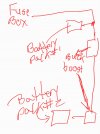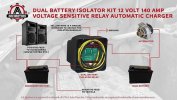knight3136
New Member
- Joined
- Feb 6, 2017
- Messages
- 16
- Reaction score
- 1
- Country
- United States

Hello everyone,
I'm trying to connect two battery packs which require 10 amps, 12V each . I want to connect both of them to an empty slot on my fuse box of my 2020 rav4. Since each needs 10 amps, I will add a 20 amps fuse on the empty slot with a fuse tap. I would run 14 awg wires from fuse tap to the first battery pack solder an XT60 connector for the first battery pack. I would then connect the 14 awg to a buck booster transformer that will increase voltage 12V at 10 amps and for the remaining 6 feet that would be connected to another buck booster 12V at 10 amps. The output of the second buck booster wlll have another xt6o cable that will connected to the second battery pack. When I connected them it was working. Today I went to startup my car and they weren't charging, I check the apps and it was showing zero voltage and amps for both battery pack. The second battery pack was showing 8V /9.1A but it immediately went down to zero and I got a message saying low voltage. The cars battery was 12.8V, I would like to know if I should go with a 25 amps fuse instead of 20 and why it work at first and then stop working. Any suggestions will be appreciated.

